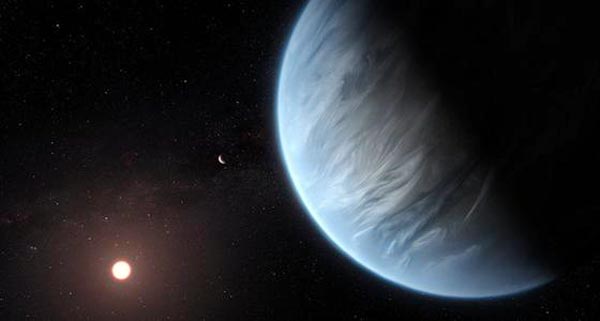Scientists may detect signs of extraterrestrial life in the next 5 to 10 years

An artistic impression of one of the exoplanets in the study, K2-18b. The image shows the planet, its host star, and an accompanying planet in this system. K2-18b is now the only gas dwarf exoplanet known to host both water and temperatures that could support life.
Credit: ESA / Hubble, M. Kornmesser, CC BY 4.0
Telescope launching this autumn could spot biosignatures on other planets within three days.
Research shows that a new telescope could detect a potential signature of life on other planets in as little as 60 hours.
“What really surprised me about the results is that we may realistically find signs of life on other planets in the next 5 to 10 years,” said Caprice Phillips, a graduate student at The Ohio State University, who will share preliminary findings at a press conference during the 2021 APS April Meeting.
Gas dwarf planets have the potential to foster life. But because none of these super-Earths or mini-Neptunes exist within our solar system, scientists struggle to determine whether their atmospheres contain ammonia and other potential signs of living things.
Phillips calculated that when the James Webb Space Telescope launches this October, it could feasibly detect ammonia around six gas dwarf planets after just a few orbits.
She and her team modeled how JWST instruments would respond to varying clouds and atmospheric conditions, then produced a ranked list of where the telescope should search for life.
“Humankind has contemplated the questions, ‘Are we alone? What is life? Is life elsewhere similar to us?'” said Phillips. “My research suggests that for the first time, we have the scientific knowledge and technological capabilities to realistically begin to find the answers to these questions.”
FEATURED TALK
Detecting Biosignatures in the Atmospheres of Gas Dwarfs With JWST (K05.2)
2:06 p.m. – 2:42 p.m. CDT, Sunday, April 18, 2021
Caprice Phillips, phillips.1622@buckeyemail.osu.edu
Livestream: Access here
Abstract: https:/
PRESS CONFERENCE
Register for the press conference to be held on Zoom at 12:00 p.m. CDT, Sunday, April 18, 2021.
Speaker:
- Caprice Phillips (Ohio State)
###
About 2021 APS April Meeting
Complimentary registration is available to journalists and public information officers for the express purpose of gathering and reporting news and information from the meeting. All prospective attendees must register to access the virtual meeting platform: https:/
Staff reporters, freelance writers, and students are welcome. Those who have not previously attended APS meetings as press or do not directly receive the APS journals tip sheet may submit a request for APS press credentials by completing the form on this page: http://info.
Please visit the April Meeting Newsroom for a list of other press conferences and presentations featuring newsworthy research.
About APS
The American Physical Society is a nonprofit membership organization working to advance and diffuse the knowledge of physics through its outstanding research journals, scientific meetings, and education, outreach, advocacy, and international activities. APS represents over 55,000 members, including physicists in academia, national laboratories, and industry in the United States and throughout the world. Society offices are located in College Park, Maryland (Headquarters), Ridge, New York, and Washington, DC.
All latest news from the category: Physics and Astronomy
This area deals with the fundamental laws and building blocks of nature and how they interact, the properties and the behavior of matter, and research into space and time and their structures.
innovations-report provides in-depth reports and articles on subjects such as astrophysics, laser technologies, nuclear, quantum, particle and solid-state physics, nanotechnologies, planetary research and findings (Mars, Venus) and developments related to the Hubble Telescope.
Newest articles

A universal framework for spatial biology
SpatialData is a freely accessible tool to unify and integrate data from different omics technologies accounting for spatial information, which can provide holistic insights into health and disease. Biological processes…

How complex biological processes arise
A $20 million grant from the U.S. National Science Foundation (NSF) will support the establishment and operation of the National Synthesis Center for Emergence in the Molecular and Cellular Sciences (NCEMS) at…

Airborne single-photon lidar system achieves high-resolution 3D imaging
Compact, low-power system opens doors for photon-efficient drone and satellite-based environmental monitoring and mapping. Researchers have developed a compact and lightweight single-photon airborne lidar system that can acquire high-resolution 3D…





















